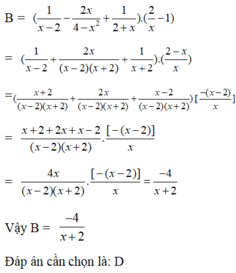Cho biểu thức B = 1 x − 2 − 2 x 4 − x 2 + 1 2 + x . 2 x − 1 . Rút gọn biểu thức B ta được
A. B = − 1 x + 2
B. B = 1 x + 2
C. B = 4 x + 2
D. B = - 4 x + 2
Hãy nhập câu hỏi của bạn vào đây, nếu là tài khoản VIP, bạn sẽ được ưu tiên trả lời.



Bài 1:
a: \(A=\dfrac{x^2-3+x+3}{\left(x-3\right)\left(x+3\right)}\cdot\dfrac{x+3}{x}=\dfrac{x\left(x+1\right)}{x\left(x-3\right)}=\dfrac{x+1}{x-3}\)
b: Để A=3 thì 3x-9=x+1
=>2x=10
hay x=5
Bài 2:
a: \(A=\dfrac{x+x-2-2x-4}{\left(x-2\right)\left(x+2\right)}:\dfrac{x+2-x}{x+2}\)
\(=\dfrac{-6}{x-2}\cdot\dfrac{1}{2}=\dfrac{-3}{x-2}\)
b: Để A nguyên thì \(x-2\in\left\{1;-1;3;-3\right\}\)
hay \(x\in\left\{3;1;5;-1\right\}\)

a)Vì |4x - 2| = 6 <=> 4x - 2 ϵ {6,-6} <=> x ϵ {2,-1}
Thay x = 2, ta có B không tồn tại
Thay x = -1, ta có B = \(\dfrac{1}{3}\)
b)ĐKXĐ:x ≠ 2,-2
Ta có \(A=\dfrac{5}{x+2}+\dfrac{3}{2-x}-\dfrac{15-x}{4-x^2}=\dfrac{10-5x+3x+6}{\left(x+2\right)\left(2-x\right)}-\dfrac{15-x}{4-x^2}=\dfrac{16-2x}{\left(x+2\right)\left(2-x\right)}-\dfrac{15-x}{4-x^2}=\dfrac{2x-16}{\left(x+2\right)\left(x-2\right)}-\dfrac{15-x}{4-x^2}=\dfrac{2x-16}{x^2-4}+\dfrac{15-x}{x^2-4}=\dfrac{x-1}{x^2-4}\)c)Từ câu b, ta có \(A=\dfrac{x-1}{x^2-4}\)\(\Rightarrow\dfrac{2A}{B}=\dfrac{\dfrac{\dfrac{2x-2}{x^2-4}}{2x+1}}{x^2-4}=\dfrac{2x-2}{2x+1}< 1\) với mọi x
Do đó không tồn tại x thỏa mãn đề bài

Bạn nên gõ đề bằng công thức toán (biểu tượng $\sum$ góc trái khung soạn thảo) để mọi người hiểu đề và hỗ trợ bạn tốt hơn nhé.

a: \(A=\left(\dfrac{2x^2+2}{x^3-1}+\dfrac{x^2-x+1}{x^4+x^2+1}-\dfrac{x^2+3}{x^3-x^2+3x-3}\right):\dfrac{1}{x-1}\)
\(=\left(\dfrac{2x^2+2}{\left(x-1\right)\left(x^2+x+1\right)}+\dfrac{x^2-x+1}{x^4+2x^2+1-x^2}-\dfrac{x^2+3}{x^2\left(x-1\right)+3\left(x-1\right)}\right)\cdot\dfrac{x-1}{1}\)
\(=\left(\dfrac{2x^2+2}{\left(x-1\right)\left(x^2+x+1\right)}+\dfrac{\left(x^2-x+1\right)}{\left(x^2+1\right)^2-x^2}-\dfrac{x^2+3}{\left(x-1\right)\left(x^2+3\right)}\right)\cdot\dfrac{x-1}{1}\)
\(=\left(\dfrac{2x^2+3}{\left(x-1\right)\left(x^2+x+1\right)}+\dfrac{x^2-x+1}{\left(x^2+1+x\right)\left(x^2+1-x\right)}-\dfrac{1}{x-1}\right)\cdot\dfrac{x-1}{1}\)
\(=\left(\dfrac{2x^2+3}{\left(x-1\right)\left(x^2+x+1\right)}+\dfrac{1}{x^2+x+1}-\dfrac{1}{x-1}\right)\cdot\dfrac{x-1}{1}\)
\(=\dfrac{2x^2+3+x-1-x^2-x-1}{\left(x-1\right)\left(x^2+x+1\right)}\cdot\dfrac{x-1}{1}\)
\(=\dfrac{x^2+1}{x^2+x+1}\)
b: Để A là số nguyên thì \(x^2+1⋮x^2+x+1\)
=>\(x^2+x+1-x⋮x^2+x+1\)
=>\(x⋮x^2+x+1\)
=>\(x^2+x⋮x^2+x+1\)
=>\(x^2+x+1-1⋮x^2+x+1\)
=>\(-1⋮x^2+x+1\)
=>\(x^2+x+1\in\left\{1;-1\right\}\)
=>\(x^2+x+1=1\)
=>x2+x=0
=>x(x+1)=0
=>\(x\in\left\{0;-1\right\}\)

\(B=\left(\dfrac{1}{x-2}-\dfrac{2x}{4-x^2}+\dfrac{1}{2+x}\right).\dfrac{2}{x-1}\)
\(\Rightarrow B=\dfrac{x+2+2x+x-2}{\left(x-2\right)\left(x+2\right)}.\dfrac{2}{x-1}\)
\(\Rightarrow B=\dfrac{4x}{\left(x-2\right)\left(x+2\right)}.\dfrac{2}{x-1}\)
\(\Rightarrow B=\dfrac{8x}{\left(x-2\right)\left(x+2\right)\left(x-1\right)}\)

a) Ta có: \(P=\dfrac{x-2}{x^2-1}-\dfrac{x+2}{x^2+2x+1}\cdot\dfrac{1-x^2}{2}\)
\(=\dfrac{x-2}{\left(x-1\right)\left(x+1\right)}-\dfrac{x+2}{\left(x+1\right)^2}\cdot\dfrac{-\left(x-1\right)\left(x+1\right)}{2}\)
\(=\dfrac{x-2}{\left(x-1\right)\left(x+1\right)}+\dfrac{\left(x+2\right)\left(x-1\right)}{2\left(x+1\right)}\)
\(=\dfrac{2\left(x-2\right)}{2\left(x-1\right)\left(x+1\right)}+\dfrac{\left(x-1\right)^2\cdot\left(x+2\right)}{2\left(x-1\right)\left(x+1\right)}\)
\(=\dfrac{2x-4-\left(x^2-2x+1\right)\left(x+2\right)}{2\left(x-1\right)\left(x+1\right)}\)
\(=\dfrac{2x-4-\left(x^3+2x^2-2x^2-4x+x+2\right)}{2\left(x-1\right)\left(x+1\right)}\)
\(=\dfrac{2x-4-\left(x^3-3x+2\right)}{2\left(x-1\right)\left(x+1\right)}\)
\(=\dfrac{2x-4-x^3+3x-2}{2\left(x-1\right)\left(x+1\right)}\)
\(=\dfrac{-x^3+5x-6}{2\left(x-1\right)\left(x+1\right)}\)
\(=\dfrac{-\left(x^3-5x+6\right)}{2\left(x-1\right)\left(x+1\right)}\)

\(a.A=\dfrac{x^2}{x^2-4}-\dfrac{x}{x-2}+\dfrac{2}{x+2}\\ \Rightarrow A=\dfrac{x^2-x\left(x+2\right)+2\left(x-2\right)}{\left(x-2\right)\left(x+2\right)}\\ \Rightarrow A=\dfrac{x^2-x^2-2x+2x-4}{\left(x-2\right)\left(x+2\right)}\\ \Rightarrow A=\dfrac{-4}{\left(x-2\right)\left(x+2\right)}\)
b, thay x=1\(\Rightarrow A=\dfrac{-4}{\left(1-2\right)\left(1+2\right)}=\dfrac{-4}{-1.3}=\dfrac{-4}{-3}=\dfrac{4}{3}\)

`a)|x-2|=2<=>[(x=4(ko t//m)),(x=0(t//m)):}`
Thay `x=0` vào `A` có: `A=[2\sqrt{0}-3]/[\sqrt{0}-2]=3/2`
`b)` Với `x >= 0,x ne 4` có:
`B=[2(\sqrt{x}-3)+\sqrt{x}(\sqrt{x}+3)-4\sqrt{x}]/[(\sqrt{x}+3)(\sqrt{x}-3)]`
`B=[2\sqrt{x}-6+x+3\sqrt{x}-4\sqrt{x}]/[(\sqrt{x}+3)(\sqrt{x}-3)]`
`B=[x+\sqrt{x}-6]/[(\sqrt{x}+3)(\sqrt{x}-3)]`
`B=[(\sqrt{x}+3)(\sqrt{x}-2)]/[(\sqrt{x}+3)(\sqrt{x}-3)]`
`B=[\sqrt{x}-2]/[\sqrt{x}-3]`
`c)` Với `x >= 0,x ne 4` có:
`C=A.B=[2\sqrt{x}-3]/[\sqrt{x}-2].[\sqrt{x}-2]/[\sqrt{x}-3]=[2\sqrt{x}-3]/[\sqrt{x}-3]`
Có: `C >= 1`
`<=>[2\sqrt{x}-3]/[\sqrt{x}-3] >= 1`
`<=>[2\sqrt{x}-3-\sqrt{x}+3]/[\sqrt{x}-3] >= 0`
`<=>[\sqrt{x}]/[\sqrt{x}-3] >= 0`
Vì `x >= 0=>\sqrt{x} >= 0`
`=>\sqrt{x}-3 > 0`
`<=>x > 9` (t/m đk)

a: Khi x=25 thì \(A=\dfrac{5+1}{5-2}=\dfrac{6}{3}=2\)
b: \(B=\dfrac{\sqrt{x}}{\sqrt{x}+1}+\dfrac{1-\sqrt{x}}{\sqrt{x}-2}-\dfrac{\sqrt{x}+4}{x-\sqrt{x}-2}\)
\(=\dfrac{\sqrt{x}}{\sqrt{x}+1}+\dfrac{1-\sqrt{x}}{\sqrt{x}-2}-\dfrac{\sqrt{x}+4}{\left(\sqrt{x}-2\right)\left(\sqrt{x}+1\right)}\)
\(=\dfrac{\sqrt{x}\left(\sqrt{x}-2\right)+\left(1-\sqrt{x}\right)\left(1+\sqrt{x}\right)-\sqrt{x}-4}{\left(\sqrt{x}-2\right)\left(\sqrt{x}+1\right)}\)
\(=\dfrac{x-2\sqrt{x}+1-x-\sqrt{x}-4}{\left(\sqrt{x}-2\right)\left(\sqrt{x}+1\right)}\)
\(=\dfrac{-3\sqrt{x}-3}{\left(\sqrt{x}-2\right)\left(\sqrt{x}+1\right)}=-\dfrac{3}{\sqrt{x}-2}\)
c: P=B:A
\(=\dfrac{-3}{\sqrt{x}-2}:\dfrac{\sqrt{x}+1}{\sqrt{x}-2}=-\dfrac{3}{\sqrt{x}+1}\)
P<-1
=>P+1<0
=>\(\dfrac{-3+\sqrt{x}+1}{\sqrt{x}+1}< 0\)
=>\(\sqrt{x}-2< 0\)
=>\(\sqrt{x}< 2\)
=>0<=x<4
mà x nguyên
nên \(x\in\left\{0;1;2;3\right\}\)

a: \(B=\left(\dfrac{x}{\left(x-2\right)\left(x+2\right)}-\dfrac{2}{x-2}+\dfrac{1}{x+2}\right):\left(x-2+\dfrac{10-x^2}{x+2}\right)\)
\(=\dfrac{x-2x-4+x-2}{\left(x-2\right)\left(x+2\right)}:\dfrac{x^2-4+10-x^2}{x+2}\)
\(=\dfrac{-6}{\left(x-2\right)\left(x+2\right)}\cdot\dfrac{x+2}{6}=\dfrac{-1}{x-2}\)
b: Khi x=1/2 thì \(B=\dfrac{-1}{\dfrac{1}{2}-2}=\dfrac{2}{3}\)
Khi x=-1/2 thì B=2/5
c: Để B nguyên thì \(x-2\in\left\{1;-1\right\}\)
hay \(x\in\left\{3;1\right\}\)
a, đk : x khác -2 ; 2
\(B=\left(\dfrac{x-2\left(x+2\right)+x-2}{\left(x-2\right)\left(x+2\right)}\right):\left(\dfrac{x^2-4+10-x^2}{x+2}\right)\)
\(=\dfrac{-6}{\left(x-2\right)\left(x+2\right)}:\dfrac{6}{x+2}=\dfrac{1}{2-x}\)
b, Ta có \(\left|x\right|=\dfrac{1}{2}\Leftrightarrow x=\dfrac{1}{2};x=-\dfrac{1}{2}\)
Với x = 1/2 ta được \(B=\dfrac{1}{2-\dfrac{1}{2}}=\dfrac{2}{3}\)
Với x = -1/2 ta được \(B=\dfrac{1}{2+\dfrac{1}{2}}=\dfrac{2}{5}\)
c, \(\dfrac{1}{2-x}\Rightarrow2-x\inƯ\left(1\right)=\left\{\pm1\right\}\)
| 2-x | 1 | -1 |
| x | 1 | 3 |